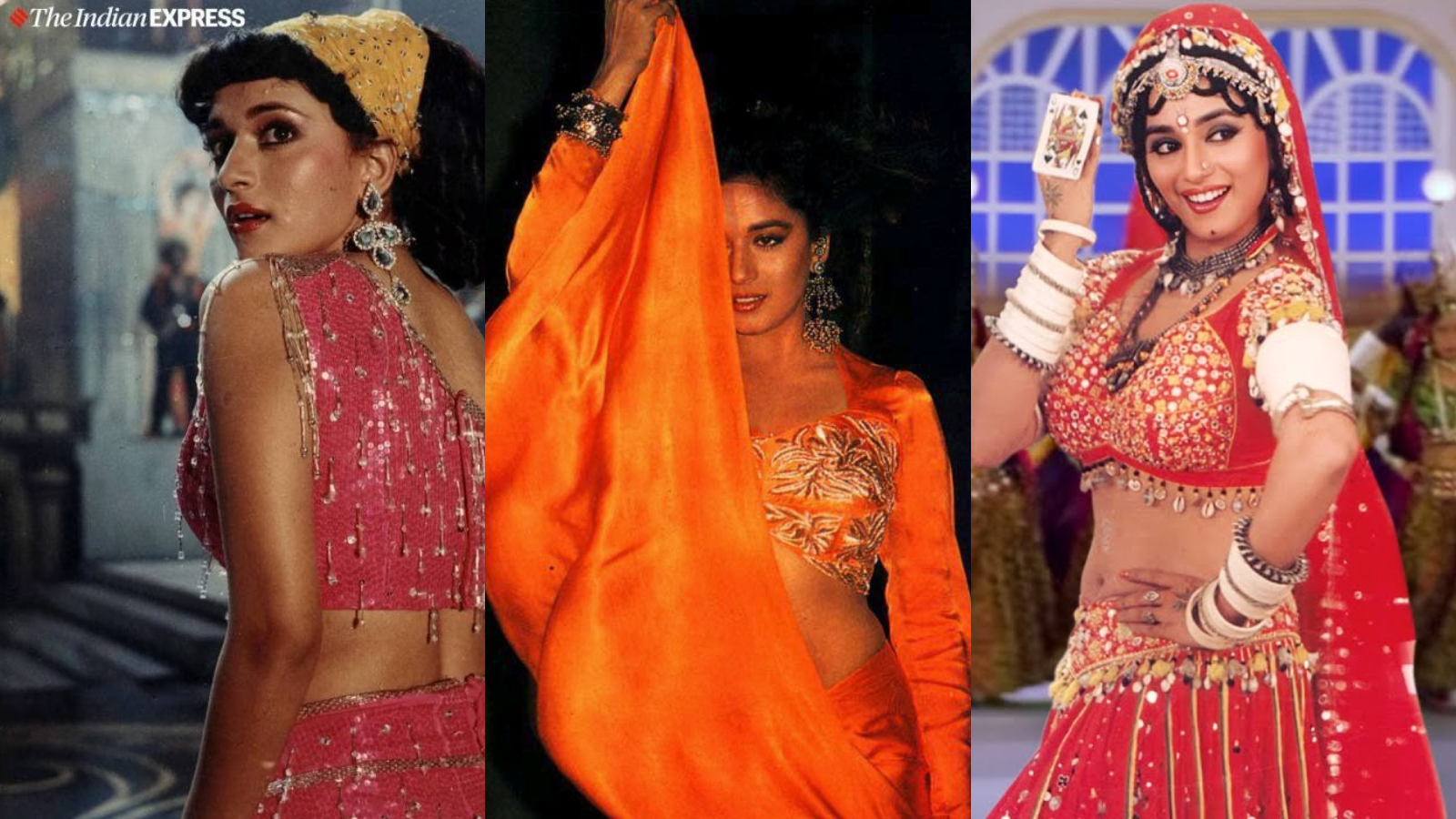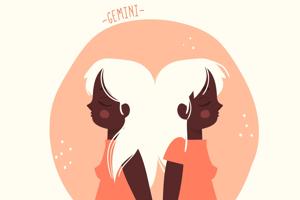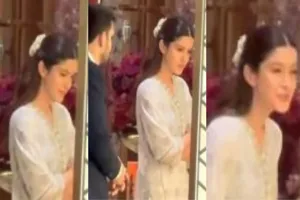
Two years later, she delivered the iconic “Dhak Dhak” dance number in Beta and played a vision-impaired dancer in the understated Sangeet. Her performance, especially in the suggestive song “Dhak Dhak” was the most striking aspect of the film. Her performance in “Dhak Dhak” marked a significant departure from the typical Bollywood dance routines of the time. Near my bust line, so I have to show Dhak Dhak.” Ultimately, her explanation convinced the board members, allowing the song to be released without any cuts. Madhuri Dixit and Saroj Khan collaborated on many songs (Express Archive Photo) Madhuri Dixit and Saroj Khan collaborated on many songs (Express Archive Photo)The collaboration between Madhuri and Saroj was nothing short of magical, with the actress and choreographer forming an unbreakable bond akin to that of an artist and their muse.
Madhuri Dixit redefined the Bollywood actress — she could be both sensual and coy in the same film, played the vengeful widow and melted the screen with her million-dollar smile. Even in the ‘80s, she didn’t fear kissing a much older actor (Vinod Khanna in Dayavan) on-screen, creating an uproar, nor did the idea of looking into the eye of her mother-in-law and defying her (Beta), in the ‘90s, ever make her uncomfortable. Madhuri Dixit Nene was more than just the ‘Dhak Dhak girl’ — the moniker in itself meant she was desired by the whole nation even as producers were willing to put money on her — the versatility in her roles, and her choices of ground-breaking scripts, which can be called ‘bold’ in the late ‘80s and the ‘90s, makes her an actor ahead of time, who managed to break the mould of the conventional heroine, despite her commercial success and gaudy, loud costumes.
ALSO READ Madhuri Dixit: The ‘Dhak Dhak’ girl who danced her way into our hearts
There is no denying that Madhuri was the commercial star who every director wanted to work with, but every once in a while she proved to be ‘different’ and ‘unconventional’ in her own right. Madhuri didn’t merely play characters; she embodied them, infusing each role with depth and nuance. In an era dominated by stereotypes, she dared to break free, choosing roles that challenged societal norms and celebrated women’s agency.
Advertisement
One such standout performance was in the iconic film Tezaab (1988), where she portrayed the feisty Mohini. Her portrayal of a young woman navigating love amidst adversity resonated deeply with audiences, establishing her as a leading lady to reckon with. In the later part of her career, she shattered stereotypes with her portrayal of Chandramukhi in Devdas (2002), infusing the character of a tawaif with empathy and resilience, transcending the typical portrayal of courtesans in Indian cinema.
WHAT MAKES HER TIMELESS?
Madhuri consistently demonstrated her ability to take risks and defy expectations. In 1989, while experiencing her first blockbuster success with Ram Lakhan, she simultaneously took on the gangland drama Parinda. In 1991, she starred in the emotional love triangle Saajan, directed by Lawrence D’Souza, and the introspective Prahaar, directed by Nana Patekar. Two years later, she delivered the iconic “Dhak Dhak” dance number in Beta and played a vision-impaired dancer in the understated Sangeet.
Madhuri played a strong and progressive character in Mrityudand (Photo: IMDb) Madhuri played a strong and progressive character in Mrityudand (Photo: IMDb)
Even at the height of her success, as seen in Dil Toh Pagal Hai (1997), she continued to challenge herself, working with Prakash Jha on one of his earliest films – the woman-oriented character drama Mrityudand. Her performance in the film is considered one of her best. The story centres on Ketaki, played by Madhuri, an educated and strong-willed young woman who is married into a family of zamindars, living in genteel poverty. Unwilling to conform to the traditional expectations placed upon her, Ketaki’s voice of dissent inspires other women in the family to question their own roles and status within society. One of the key strengths of Mrityudand lies in its subtle approach to addressing feminist themes.
Seventeen-year-old Madhuri was cast opposite Bengali actor Tapas Pal for her debut film, Abodh (Express Archive Photos) Seventeen-year-old Madhuri was cast opposite Bengali actor Tapas Pal for her debut film, Abodh (Express Archive Photos)
Her ability to seamlessly transition between commercial blockbusters and more introspective films not only broadened her range as an actress but also contributed to her enduring appeal and influence in the Indian film industry. The 1994 film Anjaam, directed by Rahul Rawail, featuring Madhuri and Shah Rukh Khan, initially failed to make an impact at the box office but eventually garnered a cult following for Madhuri’s portrayal of a woman who rises to the occasion. The film revolves around the struggles of a woman, portrayed by Madhuri, who avenges the murder of her husband. Anjaam tackles the critical issue of violence against women. While the film may have been underrated during its release, its powerful storytelling and strong performances, particularly by Madhuri, eventually led to its recognition as a ‘rare’ gem in Hindi cinema.
View this post on Instagram A post shared by Madhuri Dixit (@madhuridixitnene)
Advertisement
Madhuri and Juhi Chawla’s 2014 film, Gulaab Gang may not be considered a cinematic masterpiece, but there’s undeniable excitement in witnessing the diva confidently kneeing villains with a swagger. Her portrayal of the lead character exhibits a sense of dignity and showcases her versatility as an actress. What’s particularly noteworthy is her willingness to take on a film that defied expectations, working with a rookie director (Soumik Sen) and a lower budget than she was accustomed to in the action genre.
During a press conference held in Mumbai, Madhuri spoke about choosing Gulaab Gang and why it was a pathbreaking film. She said, “I’m trying to think of any movie in the past that in that setting of a Bollywood potboiler, has women in the key roles. A movie with all the masala, all the dialogue-baazi, and yet with a female protagonist and antagonist. A woman playing that kind of a role was fascinating, I thought because it changes the rules in one go. It’s like throwing down a bowling ball and watching the pins go flying.”
Abhishek Chaubey’s Dedh Ishqiya sees Madhuri falling for another woman, played by Huma Qureshi. Abhishek had admitted that the initial “explicit” version of the script featuring lesbian themes made Madhuri hesitant about the project. It was a choice not many actors of her stature would make, considering “same-sex” love was still considered a taboo both onscreen and in life. It is the pre-Section 377 era we are talking about. In an interview with entertainment journalist Raja Sen, Abhishek said, “She (Madhuri) told me about her fears, and I addressed it: This is exactly how I’m going to treat it. If you’re observant, you’ll get it fairly easily. However, if you aren’t watching carefully, you don’t get it, and that’s it. It doesn’t harm your enjoyment of the movie. There were absolutely no inhibitions. She was all systems go.”
WAS PAID MORE THAN HER MALE ACTORS
Madhuri’s rise to stardom was nothing short of meteoric. After a brief setback, her journey began with a series of successful films, starting with Dayavan and Tezaab in 1988. The following year, she delivered powerful performances in Tridev, Parinda, and Subhash Ghai’s Ram Lakhan, establishing her as the leading lady in Bollywood, who would guarantee box-office success. With each hit, her star power grew exponentially, and the film industry took notice. Madhuri’s demand skyrocketed as she showcased her talent and versatility, leading to an impressive number of releases – nine in 1989 and ten in 1990.
Advertisement
This also meant that she not only overshadowed her male co-stars but also charged a higher fee for her films – something that was unfathomable at that time. In one of their biggest films together, Beta, Anil Kapoor played a naive son, blind to his stepmother’s evil intentions, while Madhuri portrayed a strong woman, challenging her husband’s mother. Her performance, especially in the suggestive song “Dhak Dhak” was the most striking aspect of the film. “Beta should have been called ‘Beti,’ people tell me,” Madhuri once said. Anil naturally felt overshadowed by the spotlight on his costar.
Madhuri Dixit and Anil Kapoor in a still from Tezaab (Photo: X/anilkapoor)
“She only started Dil because Anil didn’t have dates at the time, and Aamir Khan, who had a string of unsuccessful films following his 1988 debut hit, Qayamat Se Qayamat Tak – ‘was a nobody,’” trade analyst, Amod Mehra told The Caravan. Mehra recalled how as her superstar status grew, “Nobody wanted to take on Madhuri anymore.”
Even if these actors weren’t threatened by Madhuri herself, they might have taken issue with the strong characters she played. “Most of her roles were that of canny, independent women – bright students or feisty professionals who didn’t tolerate nonsense, especially from their leading men. Mainstream directors such as Subhash Ghai – even in the loud, testosterone-filled Khalnayak, ostensibly a vehicle for Sanjay Dutt – always ensured that they wrote substantial parts for her,” he urged.
Madhuri became the reigning queen of Bollywood in the ’90s. Once producers realised that her name on the marquee ensured a strong box-office opening, she began to outshine her heroes. For instance, in Hum Aapke Hain Koun..!, not only did she enjoy higher billing than the hero, Salman Khan, but she was also paid a then-astronomical Rs 2.7 crore for the film, more than almost anybody else at the time, reported The Indian Express. “This is what happens when the heroine becomes bigger than the hero,” Mehra commented, adding “Stories and films have to be built around her stature. So they become heroine-oriented films – which then don’t work at the box office.”
Advertisement
Madhuri Dixit and Salman Khan featured in Hum Aapke Hain Kaun…! (Express Archive Photos) Madhuri Dixit and Salman Khan featured in Hum Aapke Hain Kaun…! (Express Archive Photos)
In an old video clip, that surfaced on Reddit, Madhuri, a guest on Anupam Kher’s talk show, engages in a candid conversation. Anupam brings up the subject of Madhuri earning more than her co-star Salman in Hum Aapke Hain Koun…! With a big smile, Madhuri playfully responded, “Well, agar yeh baat chali hai toh chalne do,” humorously implying that she didn’t mind if people believed the speculation.
In a 2006 interview with Filmfare magazine, SRK, who worked with Madhuri in Devdas, Dil Toh Pagal Hai and Hum Tumhare Hain Sanam, expressed his admiration for Madhuri’s exceptional talent and stardom. Despite his own celebrated career, he regarded her as a role model, referring to her as the “most solid man” he had encountered in the industry. He praised her solid thinking, emotional resilience, and strong belief system, emphasising the unique qualities that set her apart. SRK acknowledged that he felt his own abilities did not measure up to Madhuri’s, stating, “She is the only one I feel I am not as good as.”
THE DANCING DIVA WHO CREATED RIPPLES AND SOME CONTROVERSIES
When one thinks of iconic Bollywood dance numbers, Madhur’s “Dhak Dhak,” “Ek Do Teen” and “Choli Ke Peeche” are among the first to come to mind. The numbers pushed the boundaries of traditional Bollywood dance, blending traditional elements with contemporary influences and heralding a new era of sensuality in songs. Her performance in “Dhak Dhak” marked a significant departure from the typical Bollywood dance routines of the time. The fusion of traditional Indian dance elements with a sensual twist showcased her versatility as a performer and her ability to woo the audience with the movement of her hips and bust and those big expressive eyes. The song’s catchy rhythm, combined with Madhuri’s expressive and suggestive dance moves, captivated audiences and changed the way dance was perceived in Bollywood.
However, the Central Board of Film Certification (CBFC) initially raised concerns over certain scenes in the song deeming the dance steps to be deliberately “provocative” and unsuitable for audiences at the time, leading to a discussion on potential censorship of the song.
Advertisement
The CBFC wanted to chop a few scenes from “Dhak Dhak” (Photos: X/madhuriworld) The CBFC wanted to chop a few scenes from “Dhak Dhak” (Photos: X/madhuriworld)
In a 2012 documentary titled The Saroj Khan Story, choreographer Saroj Khan, who worked with Madhuri on many songs, mentioned that the board members had objections to the dance steps, particularly a scene featuring Madhuri sitting down. To address their concerns, Saroj provided a practical example using one of the board members as a reference. The member, a woman dressed in a saree and high heels, pointed out that the chest movements in the choreography appeared deliberately suggestive. Master ji asked the woman to stand up and walk to demonstrate how the body naturally moves in high heels. She explained that the hip movement naturally shifts upwards when balancing in heels. She then argued that the dance moves were essential to the performance, saying, “I have to shake the body to show that I am dancing and she (Madhuri’s character) says ‘Dhak Dhak’. From where will that sound come? From the heart. And where is the heart? Near my bust line, so I have to show Dhak Dhak.” Ultimately, her explanation convinced the board members, allowing the song to be released without any cuts.
Madhuri Dixit and Saroj Khan collaborated on many songs (Express Archive Photo) Madhuri Dixit and Saroj Khan collaborated on many songs (Express Archive Photo)
The collaboration between Madhuri and Saroj was nothing short of magical, with the actress and choreographer forming an unbreakable bond akin to that of an artist and their muse. In an interview with Mirror Online, Saroj mentioned that Madhuri, a trained Kathak dancer, could grasp dance moves quickly. However, she initially struggled with hip movements, which are not a part of the classical dance form. Despite this challenge, Saroj described Madhuri as the best student she had ever met. “Madhuri used to copy me to the tee. ‘Ek Do Teen’ was the best performance of Madhuri and it established her as a dancer. We have a beautiful journey together and Madhuri was the best student I have ever come across. She has a charming smile. But if you smile every time unnecessarily, you lose the charm. Only in certain places where it was required, we would tell her to smile. She obeyed very well, If I say, if the hand goes to a certain place, no matter how many takes we do, the hand will come there only. Madhuri practised for ‘Ek Do Teen diligently’. She practised for 17 days. On the 10th day, I told her that she is perfect and can relax. She refused and stressed to practice more (sic),” she recalled.
Madhuri continued to redefine Bollywood dance with her iconic performance in the much-controversial song, “Choli Ke Peeche” from Khal Nayak (1993). The song, which featured lyrics that were considered bold and daring, pushed boundaries even further by incorporating overtly “sensual” dance moves and “provocative” expressions. Madhuri’s dance moves showcased her fearlessness as an artist, embracing sensuality in a way that was unprecedented in Bollywood.
Madhuri’s “Choli Ke Peeche” was considered vulgar (Express Archive Photos) Madhuri’s “Choli Ke Peeche” was considered vulgar (Express Archive Photos)
“Choli Ke Peeche” which was recently recreated for the film Crew, was penned by Anand Bakshi and composed by Laxmikant-Pyarelal, and featured voices of Alka Yagnik and Ila Arun. This iconic number, also featuring Neena Gupta, caught the public’s attention while simultaneously sparking debates on the representation of women in cinema, and was criticised for “objectification of women.”
Advertisement
“My closest memory of Khal Nayak is when people labelled ‘Choli ke Peeche’ as vulgar. It was a tragedy for me… a major shock. We treated it as a folk song and presented it in an artistic way. But when the film was released, there were protests (sic),” Subhash Ghai told PTI in an interview.
The 57-year-old, who took a brief break from acting after marrying Dr Shriram Nene, and returned to the silver screen with Aaja Nachle (2007), continues to create magic on OTT, with her rare appearances in films, judging dance reality shows on small screen and her Reels social media. She proves that she has learnt to adapt herself with time and continues to be relevant. Today, Madhuri is also a producer and singer, but most importantly, she continues to be the girl who challenged the norm, she was discovered by Subhas Ghai when she was merely 17 and was working on Abodh opposite Bengali actor Tapas Pal.
©All Rights Reserved.







